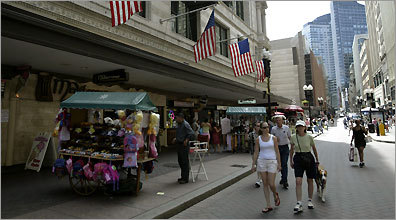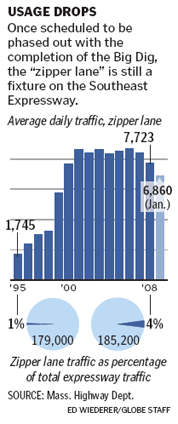 Kashgar, a city of 350,000 built around an oasis along the old Silk Road, has two time zones, two hours apart.
Kashgar, a city of 350,000 built around an oasis along the old Silk Road, has two time zones, two hours apart. 
News, trends, culture
 Kashgar, a city of 350,000 built around an oasis along the old Silk Road, has two time zones, two hours apart.
Kashgar, a city of 350,000 built around an oasis along the old Silk Road, has two time zones, two hours apart. 
 The MSPCA is seeking the owner of a stray Husky who was hit by a car in Medford around 8 a.m. on Saturday, March 21.
The MSPCA is seeking the owner of a stray Husky who was hit by a car in Medford around 8 a.m. on Saturday, March 21. The New York Times plans to eliminate several weekly sections, including its stand-alone City Section.
The New York Times plans to eliminate several weekly sections, including its stand-alone City Section.
The recession, especially the deteriorating advertising climate, is exacting a bitter toll, despite all that we have already done to reduce spending.This morning, we notified about 100 employees on the business side of The Times that their jobs were being eliminated. We thank these
dedicated colleagues for all they have contributed to The Times over the years.The broader announcement today outlines a temporary salary reduction for the remainder of the year for all
non-union employees, including the top leadership of the company. It is our hope
that these cost-cutting measures will allow us to avoid further layoffs.Although
employee pay will be cut by 5% for the remaining three-quarters of the year, you will be entitled to 10 additional personal days off over the nine months. Next year, we plan to return salaries to their current levels. Of course, such a decision depends on the state of our business.
 Strawberry Tart with Orange Cream
Strawberry Tart with Orange Cream larger than small peas. Add the egg mixture and beat just until the dough pulls together. Transfer the dough to a work surface, pat into a ball and flatten into a disk. Use the dough immediately, or wrap in plastic wrap and refrigerate until well chilled, about 30 minutes. To roll out the dough, on a lightly floured board, flatten the disk with 6 to 8 gentle taps of the rolling pin. Lift the dough and give it a quarter turn. Lightly dust the top of the dough or the rolling pin with flour as needed, then roll out until the dough is about 1/8 inch thick. Use a small, sharp knife to cut out a round or rounds 2 inches greater in diameter than your tart or larger tartlet pans. Use a small, sharp knife or a cookie cutter to cut out rounds 1/2 to 1 inch greater in diameter than your miniature tartlet pans. If using a rectangular tart pan, cut out a rectangle 2 inches larger on all sides than the pan. Makes enough dough for one 9 1/2-inch tart, six 4-inch tartlets, twelve 2-inch miniature tartlets or one 13 3/4-by-4 1/4-inch rectangular tart. Nut Dough Variation: Add 2 Tbs. ground toasted pecans, walnuts, almonds or hazelnuts to the flour mixture and proceed as directed. Make-Ahead Tip: The tart dough may be made ahead and frozen for up to 1 month. To freeze, place the dough round on a 12-inch cardboard circle and wrap it well with plastic wrap. Alternatively, use the round to line a tart pan and wrap well.
larger than small peas. Add the egg mixture and beat just until the dough pulls together. Transfer the dough to a work surface, pat into a ball and flatten into a disk. Use the dough immediately, or wrap in plastic wrap and refrigerate until well chilled, about 30 minutes. To roll out the dough, on a lightly floured board, flatten the disk with 6 to 8 gentle taps of the rolling pin. Lift the dough and give it a quarter turn. Lightly dust the top of the dough or the rolling pin with flour as needed, then roll out until the dough is about 1/8 inch thick. Use a small, sharp knife to cut out a round or rounds 2 inches greater in diameter than your tart or larger tartlet pans. Use a small, sharp knife or a cookie cutter to cut out rounds 1/2 to 1 inch greater in diameter than your miniature tartlet pans. If using a rectangular tart pan, cut out a rectangle 2 inches larger on all sides than the pan. Makes enough dough for one 9 1/2-inch tart, six 4-inch tartlets, twelve 2-inch miniature tartlets or one 13 3/4-by-4 1/4-inch rectangular tart. Nut Dough Variation: Add 2 Tbs. ground toasted pecans, walnuts, almonds or hazelnuts to the flour mixture and proceed as directed. Make-Ahead Tip: The tart dough may be made ahead and frozen for up to 1 month. To freeze, place the dough round on a 12-inch cardboard circle and wrap it well with plastic wrap. Alternatively, use the round to line a tart pan and wrap well.
 (Good article, well executed, nice angle. However: It fails to mention the main difference between NSMT and community/summer theaters -- North Shore hires Equity actors at minimums in the $500-per-week range, whereas community theaters typically pay nothing or give a small stipend with no taxes witheld. It's easy to remain profitable if you charge comparable prices to professional theaters but don't pay your workers. And summer theaters don't incur weather-related costs such as winterizing a building, paying for heat, suffering losses during snow storms, etc.)
(Good article, well executed, nice angle. However: It fails to mention the main difference between NSMT and community/summer theaters -- North Shore hires Equity actors at minimums in the $500-per-week range, whereas community theaters typically pay nothing or give a small stipend with no taxes witheld. It's easy to remain profitable if you charge comparable prices to professional theaters but don't pay your workers. And summer theaters don't incur weather-related costs such as winterizing a building, paying for heat, suffering losses during snow storms, etc.) 

 From Nagoya to Tokyo, the scenery whizzes past in a dizzying blur as the sleek engine with its bullet-like nose floats the cars along elevated tracks -- without the clickety-clack of the lumbering U.S. trains that make you feel as though you're chugging along like cattle to market.
From Nagoya to Tokyo, the scenery whizzes past in a dizzying blur as the sleek engine with its bullet-like nose floats the cars along elevated tracks -- without the clickety-clack of the lumbering U.S. trains that make you feel as though you're chugging along like cattle to market. ed control system eliminates the need for signals.
ed control system eliminates the need for signals.
Joel Stein: Solo at the birthing class -- oh baby!!
When my lovely wife, Cassandra, got the worst case of flu of her life, I happily volunteered to go to the second class alone and take notes. It turns out the easiest way to seem like a really good guy is to show up alone at a birthing class. If the other women weren't with their husbands and carrying their babies, I think I could have gotten some.

 Boston's shopping district loses its charm at night, becoming a lonely, desolate place apart
Boston's shopping district loses its charm at night, becoming a lonely, desolate place apart


 There are many places to service your car on New Street, the little road that follows the railroad tracks behind Fresh Pond Mall in Cambridge. You can get a new transmission, buy an air filter, watch the dents get knocked out of your bumper.
There are many places to service your car on New Street, the little road that follows the railroad tracks behind Fresh Pond Mall in Cambridge. You can get a new transmission, buy an air filter, watch the dents get knocked out of your bumper. A Boston Public Health Commission survey on teenagers and dating violence released yesterday offered up some pretty chilling results: Nearly half of the kids surveyed said they think Rihanna was "responsible" for what happened between her and her boyfriend, Chris Brown.
A Boston Public Health Commission survey on teenagers and dating violence released yesterday offered up some pretty chilling results: Nearly half of the kids surveyed said they think Rihanna was "responsible" for what happened between her and her boyfriend, Chris Brown.
 es of Interstate 93 south of Boston has become increasingly expensive as the Pac-Man-like trucks get older and a dwindling number of vehicles use the high-occupancy lanes.
es of Interstate 93 south of Boston has become increasingly expensive as the Pac-Man-like trucks get older and a dwindling number of vehicles use the high-occupancy lanes.Officials blame the shortage of candidates on a variety of factors, from hectic work schedules and waning interest in local affairs to the fiscal realities of these harsh economic times.
"I think it's going to be an unpleasant time to be in a legislative body, because unlike when you can vote on budgets that are moving the community forward, here we're voting on budgets where you're standing still, and that's not a lot of fun," said Reading Town Manager Peter Hechenbleikner.
"The other thing is, I think as a society, we're more focused on other things right now - like having a job."
 Down to one-third of population from more than half a decade ago
Down to one-third of population from more than half a decade ago